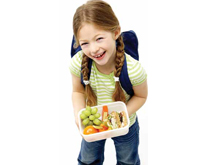 |
Good Nutrition is essential for your child, to have a great day at school. Packing a lunch is one way to ensure, that your child will have a nutritious mid-day meal, which covers her energy, protein and vitamin requirement for that period. As children are very choosy about their food, they like to have food that they can carry while playing. They are more attracted towards colour, texture and appeal of the food and not towards nutrition. Maggi, pizza, burger, pasta, potato chips and macaroni are on the top of the list, which basically have high glycemic index and low nutrition content. They usually make the child fat not fit.
|
Requirement of preschoolers and elementary students are more of protein, vitamin and mineral rich diet, as this is thei growth period, in which muscles get built, organs develop, an increase in the height and weight proportion happens. For normal functioning of the body, macro and micro nutrient requirements increase.
Points to Pack
Here are some points to keep in mind, while packing your child’s lunch box:
- Lunch to be packed in small portions that are easy to eat, because children have smaller appetite, smaller hands and mouth, that may make it difficult to eat large sized meals.
- More concentration should be on vitamins and protein, rather than calories. Eg. do not use refined flour in preparing the food for your child, as it has calories not vitamins.
- Include foods with varied tastes, textures and colours. Include something salty such as stuffed besan chila, something sweet such as fruit cake and something sour like juice. Try to have at least one crispy item such as vegetable cutlet or dal papad.
- Talk to your kids and prepare something new that will fulfill their needs and wishes of your child too. For instance, if you child insists on Maggi, then add vegetables to it.
- Use mutual supplementation technique to provide good nutrition to your child. It is a technique in which two different food items are used. Combination of both completes the lack of the other, for eg. rice and dal together give all the amino acids (components of protein) required.
|
Daily Food Requirement
Preschoolers: Generally, preschoolers need about 1,000 to 1,400 calories per day. For this age group, roughly five or six mini-meals throughout the day are preferable to keep their energy levels up.
Elementary School Students: Complex carbohydrates and protein are particularly important for five to eleven year-olds, who need roughly from 1,400 to 2,000 calories a day. If they are very active, their calorie intake can be in the upper range and if they are inactive, they should have less.
Middle and High-School Students:Generally, teenagers need anywhere from 1,600 calories per day to 3,000 calories for very active boys. Often, teenagers need more calcium and protein than they take in. |
Keep these tips in mind, in addition to those you will get from your child’s doctor. Take your child to a doctor for a general health check-up yearly or as recommended by your child’s doctor. As children, their body is very needy, in order to set a strong health base as an adult. So make sure, you make no mistakes! |
Neha Gupta is Lfestyle Counselor, Apollo Life, Delhi.
|
|